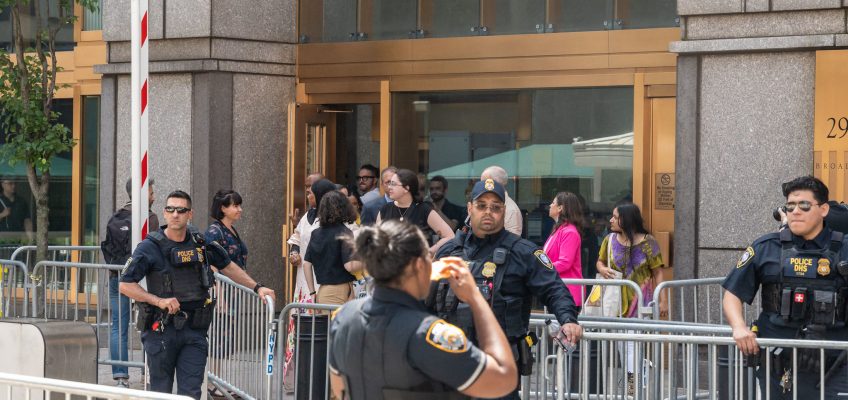As the Trump administration ramps up its deportation efforts through courthouse arrests, more migrant youth — many of whom are, or were recently, living in city shelters — are seeking guidance on how to navigate their immigration hearings.
Immigration officers outside 26 Federal Plaza in June. (Ayman Siam/Office of NYC Comptroller)
After his immigration hearing ended in August, what the 21-year-old from Guinea feared most happened. At the exit door, agents from the U.S. Immigration and Customs Enforcement (ICE) stopped him and asked for his documents.
Upon entering the courtroom earlier, he had seen ICE agents patrolling the halls of 26 Federal Plaza, where they’ve been targeting immigrants appearing for routine hearings for arrest and deportation.
“I started shivering, because I’m not used to being detained like that,” the 21-year-old said.
City Limits is withholding his identity as he fears it could jeopardize his petition for Special Immigrant Juvenile status, which protects qualifying minors from deportation and allows them to work. “I gave [my documents] to them, and they went through the list. They didn’t see my name, so they went through it for the second time.”
During those moments, one of the volunteers accompanying the young man to court held his hand and moved closer to him, in case agents moved to arrest him.
“They didn’t see my name, so they let me go,” the 21-year-old recounted. “When I entered the elevator, I was feeling like a big relief getting off me, because at that moment I thought I was going directly [to detention].”
Since late May, when the Trump administration ramped up its deportation efforts by targeting those showing up for scheduled immigration hearings, young migrants—many of whom are, or were recently, living in city shelters—are seeking guidance on how to prepare. They’ve expressed fear of appearing in person at court, and uncertainty over what to do if they are arrested.
Many of them are turning to the city’s youth-centered organizations for help, which have seen demand for their services increase quickly as they struggle to represent everyone who needs it.
“The numbers have just—we can’t keep up,” said Beth Baltimore, the deputy director of the legal services center at The Door, a nonprofit in Manhattan.
Previously, The Door would see just a couple of people during its weekly hour-long legal clinic, Baltimore said. Now, they see more than 20 people on average in about two hours.
On a visit in mid-August, City Limits observed 17 young people attend the clinic, where paralegals, attorneys, social workers, and volunteers spread out across five round tables that were always busy.
The scene during a recent legal clinic at The Door, a nonprofit youth services organization. (Daniel Parra/City Limits)
“We’re unable to even meet with everybody at this time because there’s more people coming with really extreme fear. So people are coming and saying: ‘I’m scared to go to immigration court. What do I do?’” Baltimore said.
So far, she said, at least two of their members have been arrested by ICE, although she believes there are more.
Earlier this month, The Door—among other New York organizations—sued the U.S. Department of Homeland Security and ICE for arresting migrants following check-ins at immigration courts, arguing the practice violates federal law.
Mayor Eric Adams’ administration filed an amicus brief in the case last week in support of The Door’s argument, saying courthouse arrests make the city less safe by discouraging immigrant New Yorkers from interacting with the legal system and other aspects of public life.
“No one in our city should feel forced to hide in the shadows or be afraid to use resources, and that includes sending children to school, going to a hospital when sick, calling 911 when in danger, or going to a court hearing when called upon to do so,” Adams said in a statement.
Some of those being targeted are living in the shelter system, which saw an influx of new immigrant arrivals over the last few years, though the numbers have dropped significantly in recent months. When asked, City Hall didn’t provide a number for how many teens and young adults are currently housed in the few remaining emergency shelters for migrants.
But as of Aug. 20, there were 56 migrants between the ages of 18 and 20 at more traditional shelters run by the Department of Homeless Services (DHS), and 223 between the ages of 21 and 24. That’s down from March of last year, when there were 852 immigrants aged 17 to 20 living in shelters.
‘Am I going to get detained too?’
Before his court appearance, the 21-year-old Guinean attended one of The Door’s legal clinic sessions, and his advocates filed a motion asking if he could attend his hearing virtually, to avoid having to appear in person. But the court turned that request down.
City Comptroller Brad Lander visiting one of The Door’s legal clinics last week. (Ayman Siam/Office of NYC Comptroller)
The day before his court date, the young man was hit by a car while riding a bike. His advocates then asked to reschedule his appearance, but were again turned down.
“The day I went for my hearing,” the young migrant recalled, “the guy who left the [court] hall before me got detained, and I was feeling like—whoa, am I going to get detained too? Because that guy was with people, he was with his lawyer.”
A few months ago, one of his friends from the shelter system was detained after an immigration hearing. After that, the 21-year-old migrant said, he began to fear his own court date. He already knows what it’s like to be detained: Before arriving in New York City, he said he spent a few days in immigration custody after crossing the border in 2023.
Safe Horizon’s Streetwork Project, which serves runaway and homeless youth in New York City, has also noticed a rise in the number of young people seeking help with court dates and asylum applications.
“I would say we have maybe a little under a dozen young folks who specifically reached out around their court appearances,” said Sebastien Vante, associate vice president of Safe Horizon’s Streetwork Project in Harlem. They’ve begun preparations to escort young people through hearings in response to the demand.
“We’re adapting to the needs that the young people have. And this is [the] new need that’s emerging around support,” Vante explained.
‘Leading a lamb to the slaughter’
A 20-year-old from Guinea, whose name City Limits is withholding for fear of immigration repercussions, started hearing about the courthouse arrests from his high school classmates after ICE arrested a student in the Bronx in May.
The young man arrived in New York at the end of 2023, lived in adult shelters for a while, and has been attending a public school in the city to finish his high school education since September 2024. He dreams of going to college.
Before his court date, he was torn between studying business and law; but after his experiences in immigration court, the young man said he decided he doesn’t want to be a lawyer anymore.
In July, one of his friends panicked after learning his court date had been moved up, leaving him with only a few days left to prepare. Shortly thereafter, the 20-year-old checked his own court date out of curiosity: it had also been moved up, from early 2026 to August.
A couple of days before he was due to appear, the young man’s family messaged to inform him that his mother, back in West Africa, was hospitalized and in a coma.
Hours later, this news—on top of the compounding fear of going to court in less than 48 hours—prompted the 20-year-old to run away in the middle of the night from the studio apartment where he lived with three other friends.
Early in the morning, he texted his mentor, Angel, an advocate for runaway and homeless youth (who asked City Limits to identify him by his first name only). “While I’m like this, I breathe with difficulty, and I’d rather kill myself than go back to Guinea… I don’t know what to do with my life. It’s torture,” the young man wrote.
After reading the message, Angel and Charlotte Soehner, director of youth services with an organization called Resources, Opportunities, Connections & Community (ROCC NYC), urged him to come back home and attend his court hearing.
“I know what the right thing to do was, but there was that part of me, too, that was like, am I leading a lamb to the slaughter here? Like, maybe he’s not that wrong, but I knew what we had to do,” Angel said.
Soehner said that they prepared a motion asking the court to change the young man’s hearing to a virtual appearance, but that request wasn’t granted, so advocates moved fast to prepare his case. They joined a large group, including local officials and faith leaders, to escort him in and out of court. Even his English teacher’s mother came.
New York City Council members and Public Advocate Jumaane Williams at a press conference last week calling on ICE to release Brooklyn high school student Mamadou Mouctar Diallo. (John McCarten/NYC Council Media Unit)
He isn’t the only New York City public school student navigating the threat of ICE. Over the last two months, the enforcement agency’s New York City field office (which includes Long Island and other regions outside the five boroughs) has arrested dozens of immigrant children. That includes a 6-year-old enrolled at P.S. 89 in Queens who was deported alongside her mother last week, news site THE CITY reported.
A spokesperson for New York City Public Schools (NYCPS) said via email that the department “stands with all of our students, and we are committed to supporting every child and family in our system.”
“When we hear about a family that is being detained, we have—with their permission— connected them with community and agency partners who can offer legal support and other resources,” the spokesperson added. “We want to reassure all families: our schools are safe, welcoming places, and we encourage you to continue sending your children to school, where they are cared for and valued.”
When asked if they are keeping track of how many of their students have been arrested, detained, or deported, NYCPS did not provide details.
Both young men who spoke to City Limits acknowledged that they were fortunate not to get arrested by ICE. Some of their peers are now experiencing the same panic they both felt before their own court dates, they said.
“It’s so unfair that kids who get lucky in meeting advocates have such an advantage in visibility around their case,” Soehner said. “And for all of the [young migrants] who have Brad Lander, and Beth, and Angel there, there are hundreds whose stories are not known, and it shouldn’t be that way.”
To reach the reporter behind this story, contact Daniel@citylimits.org. To reach the editor, contact Jeanmarie@citylimits.org
Want to republish this story? Find City Limits’ reprint policy here.
The post ‘Really Extreme Fear’: Advocates See Uptick in Young Migrants Afraid to Go to Court appeared first on City Limits.




